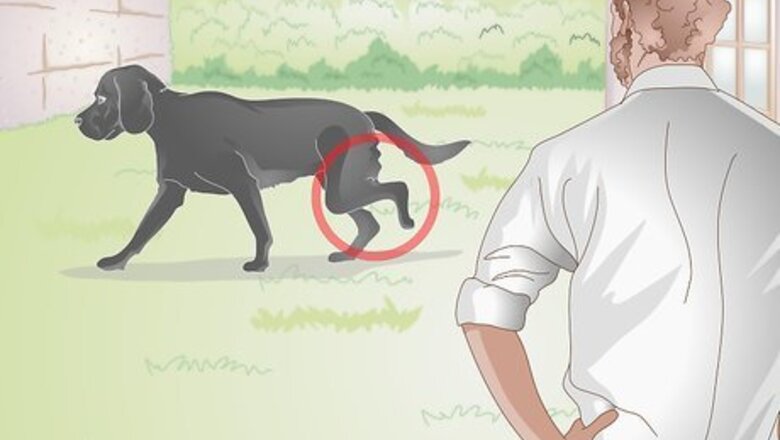
views
Assessing the Injury
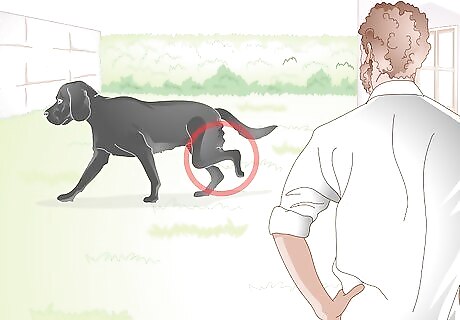
Learn the signs of injury. Sometimes, when a dog has been injured, you'll be able to see it right away. Other times, the injury will be harder to detect. Make sure to take note of the following signs of injury: Limping or other changes in walking or movement Swelling Avoidance of touch in certain areas, or barking or whining when touched in a certain spot Unexplained and unusual warmth in a certain area

Protect yourself. Even a dog which is normally kind and docile is more likely to behave in a hostile way if injured. If you suspect a dog is injured, always take care not to be bitten or otherwise injured. To the extent that you are able, avoid the dog's face and mouth. While your first impulse may be to comfort the animal, do not hug or squeeze it. Approach the dog slowly and calmly, to avoid frightening it any more than it may be already. Covering the dog's head gently with a towel or other piece of fabric can sometimes lessen its anxiety during examination.
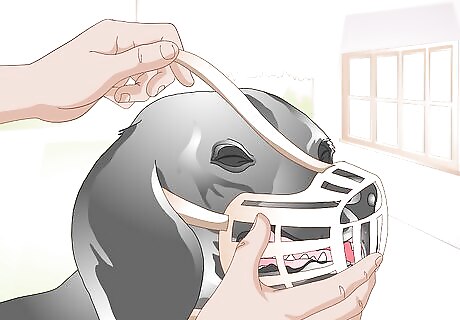
Muzzle the dog if necessary. If an injured dog attempts to bite you or shows signs of hostility, you may need to cover its mouth to avoid bites. If you already have a muzzle for your dog, carefully put it on him or her. If not, you can wrap the dog's mouth using a towel, stockings, a roll of gauze, or any similar strip of fabric. Wrap it over the dog's snout and under its chin, being careful not to cover its nose or obstruct its breathing. Never muzzle a dog that is vomiting. This can cause it to choke. Never muzzle a dog with chest injuries or a short-snouted dog such as a pug or bulldog.
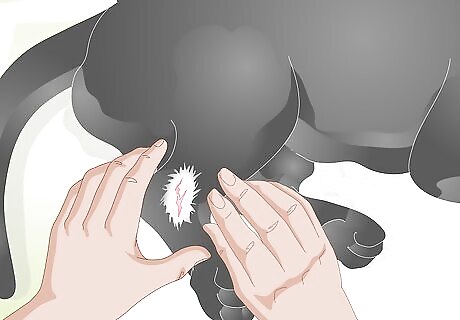
Examine the dog slowly and carefully. Look the dog over to determine where and how it is injured, being as careful as you can not to startle or further hurt it. Speak gently and calmly to the dog as you examine to help it stay calm. Stop the examination if the dog becomes obviously agitated. If the dog has a cut or similar wound, you may need to clip away some of the dog's fur to get a clear look at how bad it is. Spreading a little petroleum jelly over the wound can prevent hair clippings from getting stuck in it.
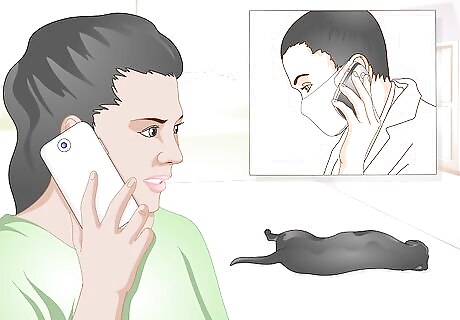
Call a vet immediately if emergency care is needed. Some injuries are minor and can, if necessary, wait to be treated by your regular vet. Life threatening injuries, however, require immediate care, and if your vet isn't available, you'll need to contact an emergency veterinary clinic. Get emergency care for the following: Profuse or unstoppable bleeding Loss of consciousness Inability to stand Difficulty breathing or rapid breathing Paralysis Note that if the injured dog is not yours, and you bring it to a vet, you may be responsible for any costs related to its care. EXPERT TIP Colleen Demling-Riley, CPDT-KA, CBCC-KA, CDBC Colleen Demling-Riley, CPDT-KA, CBCC-KA, CDBC Canine Behavior Consultant Colleen Demling-Riley (CPDT-KA, CBCC-KA, CDBC) is a Canine Behavior Consultant and the Founder of Pawtopia Dog Training. With more than 20 years of experience, she specializes in creating and customizing dog management programs for dog owners. She is a Certified Pet Dog Trainer-Knowledge Assessed, Certified Behavior Consultant Canine-Knowledge Assessed, Certified Dog Behavior Consultant, and American Kennel Club Canine Good Citizen Evaluator. Colleen is a member of the International Association of Canine Professionals and has been a featured expert in national media including the New York Times, Woman’s Day, Readers Digest, Cosmopolitan, and Yahoo.com. Colleen Demling-Riley, CPDT-KA, CBCC-KA, CDBC Colleen Demling-Riley, CPDT-KA, CBCC-KA, CDBC Canine Behavior Consultant Call the vet for guidance if your dog is in pain. Make your dog comfortable while you attempt to locate the source of their pain. Put them on a soft bed or blankets in a safe and cozy place where they can rest. I recommend choosing a less-busy area of the house, like a crate or bed in the corner of the family room. Don't hesitate to call your vet immediately to find out what you should do.
Giving First Aid
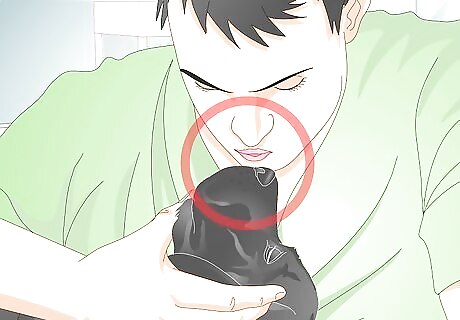
Perform CPR if needed. If a dog is not breathing, you may need to perform CPR. Close the dog's mouth and place your lips over its nose. Give three to four strong breaths. If the dog does not start breathing on its own, continue to give it 10 to 12 breaths per minute. If you can't detect a heart beat, lay the dog on its side and compress its chest with your hands. Give five compressions per breath. Once a dog starts breathing on its own, stop CPR.
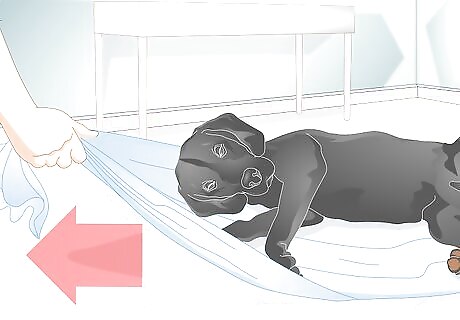
Move the dog carefully. There is a good chance you will need to move the injured dog, whether you are bringing it home, taking it to a vet, or just trying to get it out of a busy street. An injured dog must be moved gently and with great care. If you are able to, splint, bandage or otherwise stabilize wounded areas before moving the dog to reduce the risk of further harm. Confine the dog while moving it so it can't hurt itself more. If possible, use a pet carrier, but if you don't have one, punch some holes in a box. Larger dogs can be moved using a makeshift stretcher. You can use a board, a door, a rug, or a large blanket, carried by at least two people.
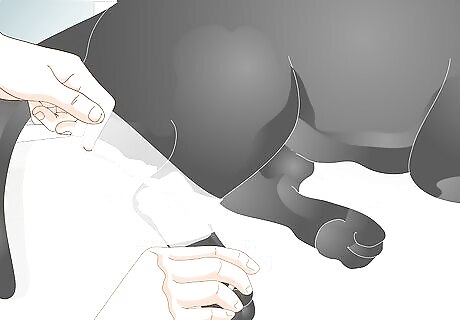
Stop any bleeding. If the dog is bleeding from its injury, press down firmly on the injured area with your fingers and palm and apply a firm but not tight bandage. Gauze or a washcloth or towel will often do the trick. If the bandage becomes soaked through with blood, don't remove it. Place additional materials on top.
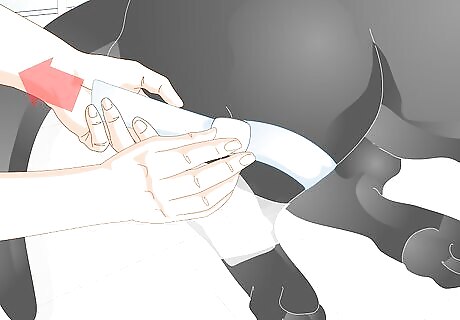
Apply a tourniquet if necessary. If a dog has an injury on it's leg or tail that will not stop bleeding, and is gushing blood in a rhythmic way, it may have a damaged artery. You may need to apply a tourniquet to save its life. Wrap the limb in a bandana or other strip of cloth, between the wound and the heart, tightly enough that no blood can pass through. Every 15 minutes, loosen the tourniquet so blood can pass through for about 10 seconds. If you don't, the dog may lose the limb. Always seek immediate emergency care for a wound of this nature..
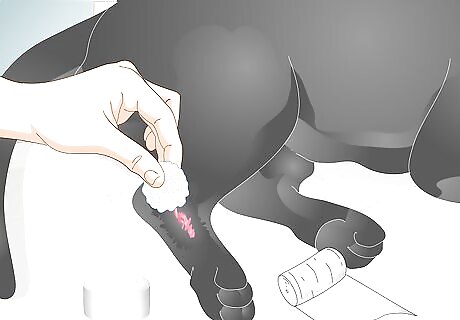
Clean and treat lacerations. If the dog has any lacerations that aren't bleeding, clean them with an antiseptic solution, such as hydrogen peroxide, and dry them. If you don't have an antiseptic solution, warm water with a little salt will do. Pat the area dry with some sterile gauze. You can apply some ointment if its not an area the dog can lick. Keep an eye on the injury in case of infection and make sure to keep it clean for several days.
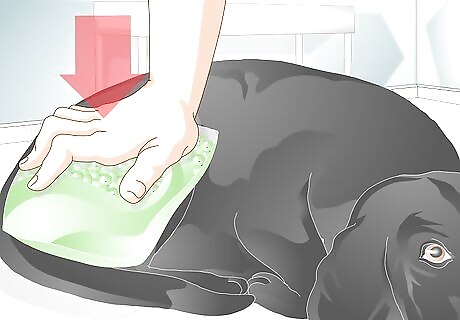
Use a cold compress. For bruising or tenderness, you can give your dog some immediate relief using a cold compress. Gently place something frozen, such as a bag of frozen peas, on the injured area. Cool the affected area for 10 to 15 minutes, then remove the compress. You can reapply as often as every two hours if it seems to be helping. If your dog is limping due to a sprain the best thing you can do is to have them rest for 1-2 days. Avoid letting them jump onto the couch and walk up and down stairs.
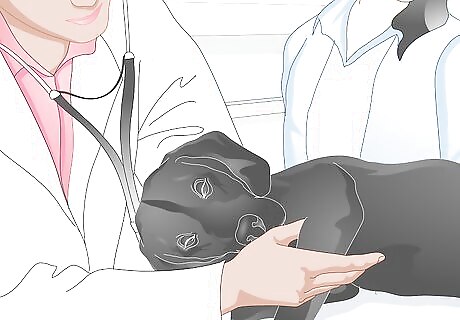
Seek veterinary care. Even for what seems like a minor injury, it is a good idea to seek professional care. You may not be able to detect some injuries, such as those that are internal. For non-emergencies, call your vet and explain the situation. The vet's office will either make an appointment for you soon or refer you to emergency care if they deem it necessary. For serious bleeding or other major injuries, search online for an emergency vet clinic near you and take your dog immediately.
Treating Long-Term Injuries
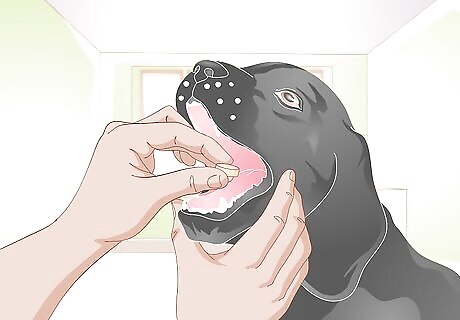
Give the dog medications. Some injuries last a long time, sometimes even for the rest of the dog's life. Treating these injuries requires patience and consistency. To begin with, give your dog any medicine your vet prescribes, following all instructions precisely. There are variety of medications available for treating the pain that may result from an injury, from anti-inflammatory medications to opioids and more. Talk to your vet about the benefits and possible side effects of any medications he or she recommends.
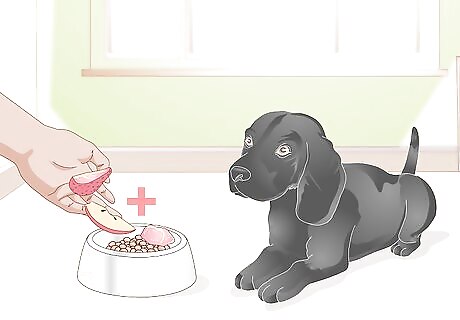
Make dietary changes. Changing what your dog eats can also be helpful in treating injuries. For injuries that have resulted from weakened tissue, a high-quality, meat-based diet is best. There are also a number of supplements, foods, and dog treats formulated especially for helping dogs with joint injuries.

Use splints and braces as appropriate. If your dog has sustained an injury that makes it difficult to walk or stand, it may benefit from a splint, brace, or cart. There are number of such products available for both short and long-term use. Your vet will be able to help you select the most appropriate option for your dog.
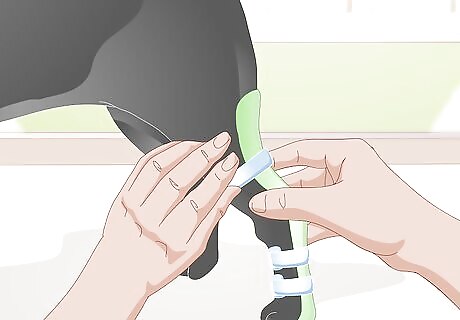
Try gentle massage. Some dogs will benefit from a gentle massage of the injured area, once it is no longer too sensitive. Lightly rub affected areas. If the dog exhibits any sign of discomfort, discontinue this immediately. This should be a pleasant experience for your dog, not a painful one.
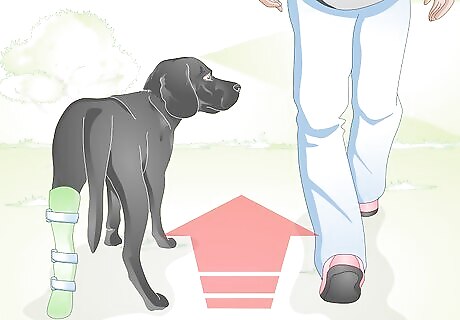
Keep exercise moderate. An injured dog should not overly exert itself, as this may result in further injury/re-injury of the damaged area. Make sure the dog doesn't, for example, walk or run for too long on an injured leg. Total lack of exercise isn't a good idea either. This can result in a dog becoming overweight, which can produce its own problems, especially for dogs that have joint injuries. EXPERT TIP Colleen Demling-Riley, CPDT-KA, CBCC-KA, CDBC Colleen Demling-Riley, CPDT-KA, CBCC-KA, CDBC Canine Behavior Consultant Colleen Demling-Riley (CPDT-KA, CBCC-KA, CDBC) is a Canine Behavior Consultant and the Founder of Pawtopia Dog Training. With more than 20 years of experience, she specializes in creating and customizing dog management programs for dog owners. She is a Certified Pet Dog Trainer-Knowledge Assessed, Certified Behavior Consultant Canine-Knowledge Assessed, Certified Dog Behavior Consultant, and American Kennel Club Canine Good Citizen Evaluator. Colleen is a member of the International Association of Canine Professionals and has been a featured expert in national media including the New York Times, Woman’s Day, Readers Digest, Cosmopolitan, and Yahoo.com. Colleen Demling-Riley, CPDT-KA, CBCC-KA, CDBC Colleen Demling-Riley, CPDT-KA, CBCC-KA, CDBC Canine Behavior Consultant When your dog is having health issues, give them extra care and attention. Make your dog as comfortable as possible. Put them on a soft bed or blankets in a quiet spot where they can rest peacefully, like a crate in a quiet corner of the family room. Give them space and avoid forcing them to walk or play. These comforting gestures can make a big difference in how your dog feels while they're sick or uncomfortable.
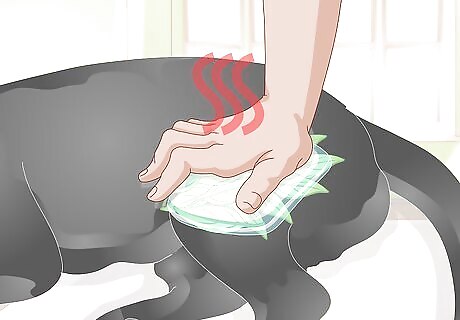
Try herbal remedies. There are a number of herbal remedies that some people have found helpful in soothing the pain of an injured dog. Although these are not medically proven, you may wish to try the following: Boswellia, bupleurum, cayenne, ginger, turmeric, and yucca have all been used to relieve joint pain in both people and animals. They can be applied in compresses. Hot compresses with these herbs, applied for 10 to15 minute intervals every two to four hours may help relieve your dog's pain. A cool compress with peppermint can have an immediate soothing effect.

















Comments
0 comment